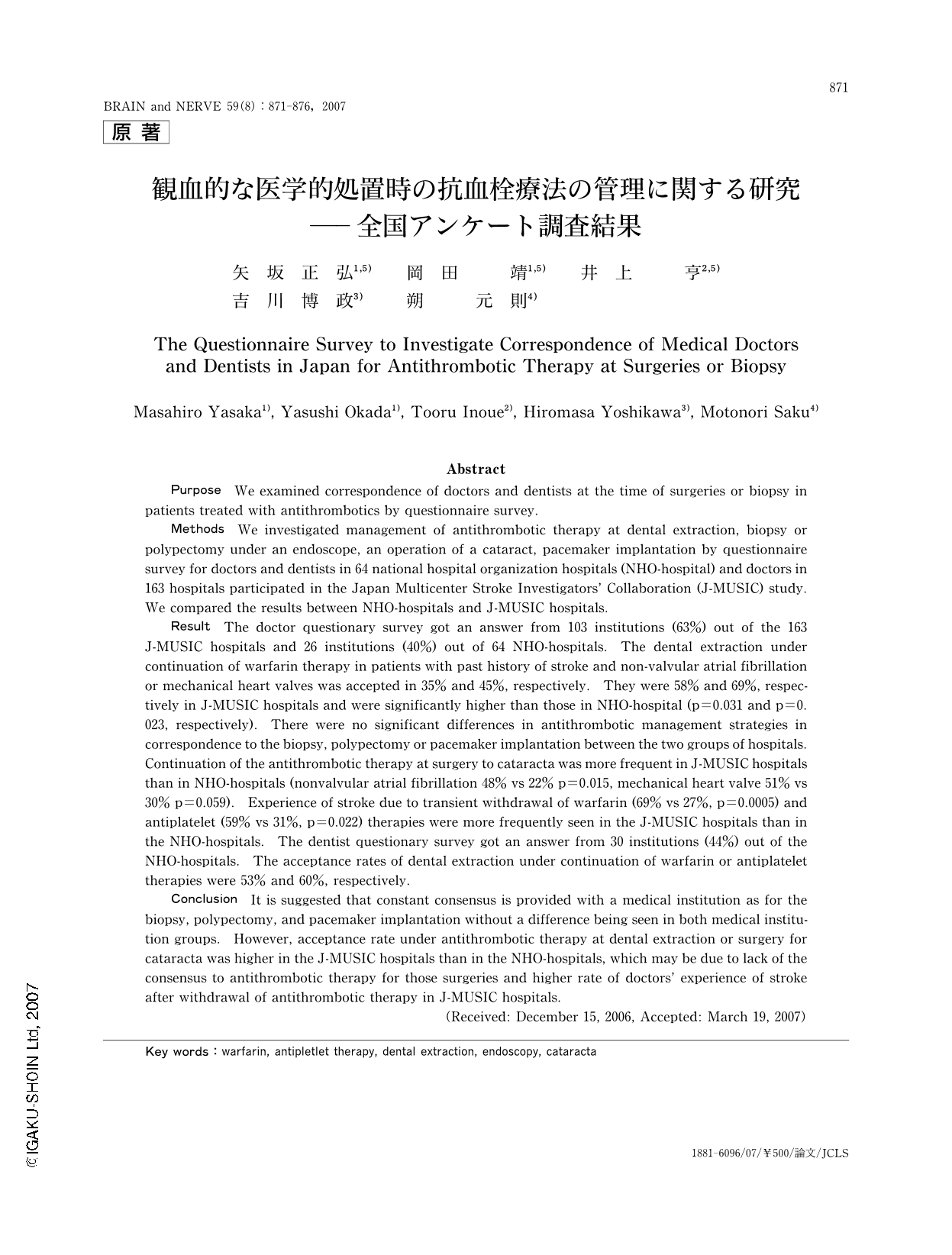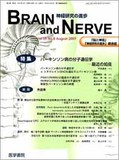Japanese
English
- 有料閲覧
- Abstract 文献概要
- 1ページ目 Look Inside
- 参考文献 Reference
はじめに
高齢化社会を迎え,高齢者を中心とする多くの人々が血栓症や塞栓症の予防を目的として抗血栓療法を受けている。抗血栓療法中に観血的な医学的処置が必要となった場合,抗血栓療法を継続すべきか,それとも一時中止すべきかという問題が生じる。抗血栓療法を継続すれば医学的処置に伴う出血性合併症の懸念があり,中止すれば脳梗塞などの血栓性あるいは塞栓性疾患の発症や再発が心配されるからである。
抗血栓療法中に観血的な医学的処置を行う場合の対応は極めて混乱しており,日本脳卒中協会へも脳卒中患者からの問い合わせが寄せられている。抜歯時の抗血栓療法の管理については,2004年に発表された日本循環器学会編「循環器疾患における抗凝固・抗血小板薬療法に関するガイドライン」に記されている1)。また内視鏡検査時の抗血栓薬使用指針が2005年に日本消化器内視鏡学会誌上で発表されている2)。しかし,これらのガイドラインや指針がどの程度一般の医師や歯科医師に影響を及ぼしているかも不明である。本研究では国立病院機構所属施設に勤務する医師や歯科医師と,脳卒中診療件数の多い病院に勤務する医師を対象に抗血栓療法中の抜歯,内視鏡下での生検,内視鏡下でのポリープ除去術,白内障の手術,およびペースメーカー植え込み時の対応を調査し,本邦における抗血栓療法中の観血的医学的処置時の対応の実態を明らかにするとともに,脳卒中診療医師のそれらへの対応が,国立病院機構所属施設に勤務する医師と差異があるかについても調査した。
Abstract
Purpose We examined correspondence of doctors and dentists at the time of surgeries or biopsy in patients treated with antithrombotics by questionnaire survey.
Methods We investigated management of antithrombotic therapy at dental extraction,biopsy or polypectomy under an endoscope,an operation of a cataract,pacemaker implantation by questionnaire survey for doctors and dentists in 64 national hospital organization hospitals (NHO-hospital) and doctors in 163 hospitals participated in the Japan Multicenter Stroke Investigators' Collaboration (J-MUSIC) study. We compared the results between NHO-hospitals and J-MUSIC hospitals.
Result The doctor questionary survey got an answer from 103 institutions (63%) out of the 163 J-MUSIC hospitals and 26 institutions (40%) out of 64 NHO-hospitals. The dental extraction under continuation of warfarin therapy in patients with past history of stroke and non-valvular atrial fibrillation or mechanical heart valves was accepted in 35% and 45%,respectively. They were 58% and 69%,respectively in J-MUSIC hospitals and were significantly higher than those in NHO-hospital (p=0.031 and p=0.023,respectively). There were no significant differences in antithrombotic management strategies in correspondence to the biopsy,polypectomy or pacemaker implantation between the two groups of hospitals. Continuation of the antithrombotic therapy at surgery to cataracta was more frequent in J-MUSIC hospitals than in NHO-hospitals (nonvalvular atrial fibrillation 48% vs 22% p=0.015,mechanical heart valve 51% vs 30% p=0.059). Experience of stroke due to transient withdrawal of warfarin (69% vs 27%,p=0.0005) and antiplatelet (59% vs 31%,p=0.022) therapies were more frequently seen in the J-MUSIC hospitals than in the NHO-hospitals. The dentist questionary survey got an answer from 30 institutions (44%) out of the NHO-hospitals. The acceptance rates of dental extraction under continuation of warfarin or antiplatelet therapies were 53% and 60%,respectively.
Conclusion It is suggested that constant consensus is provided with a medical institution as for the biopsy,polypectomy,and pacemaker implantation without a difference being seen in both medical institution groups. However,acceptance rate under antithrombotic therapy at dental extraction or surgery for cataracta was higher in the J-MUSIC hospitals than in the NHO-hospitals,which may be due to lack of the consensus to antithrombotic therapy for those surgeries and higher rate of doctors' experience of stroke after withdrawal of antithrombotic therapy in J-MUSIC hospitals.

Copyright © 2007, Igaku-Shoin Ltd. All rights reserved.


